The third-highest ranking politician of the USA has landed in Taiwan. As expected, in response to Nancy Pelosi’s arrival, China dispatched its military forces: Aircraft of the Chinese Air Force scratched the center line of the strait between the island and the mainland. In addition, naval exercises with live ammunition will begin on Thursday in the waters around Taiwan. For an assessment of the Chinese response, check our analysis by Christiane Kuehl. Pelosi’s gamble seems to have paid off in the short term because an escalation has failed to materialize. Nonetheless, the United States will have a harder time dealing with China from now on.
China’s overly vocal propagandists now have to row back. But China still holds the stronger cards and will now “play them one by one,” wrote Hu Xijin, the ever vociferous former editor-in-chief of the Global Times, on Twitter. So instead of the “great war in the Taiwan Strait” he announced on Monday, the situation has turned into a card game. (Be sure to check our Dessert section, where Hu Xijin can be seen unusually close with Pelosi).
However, relations between the United States and China will now become even more complicated. Xi Jinping cannot simply overlook the historic visit. Moreover, the risk of a misunderstanding and an unintended escalation have not been averted, especially since both sides are massing warships in the same sea area. Taiwan remains one of the most critical hot spots, alongside the ongoing war in Ukraine, North Korea and Iran.
Pelosi’s visit now strengthens symbolic support for Taiwan, but it comes at a precarious time. The world already looks distraught at one war. And China is at the point where it could push to show its newly regained technological-military strength in action. As commendable as Pelosi’s tenacity is, it has shaken a status quo that secured a delicate peace for decades.
At the same time, however, the reaction on Tuesday evening initially seemed like a game. The moment flight tracking sites signaled Pelosi’s landing, the Chinese and American sides posted their PR pieces online, boldly proclaiming their positions. It was almost reassuring that they used the same phrases as usual.

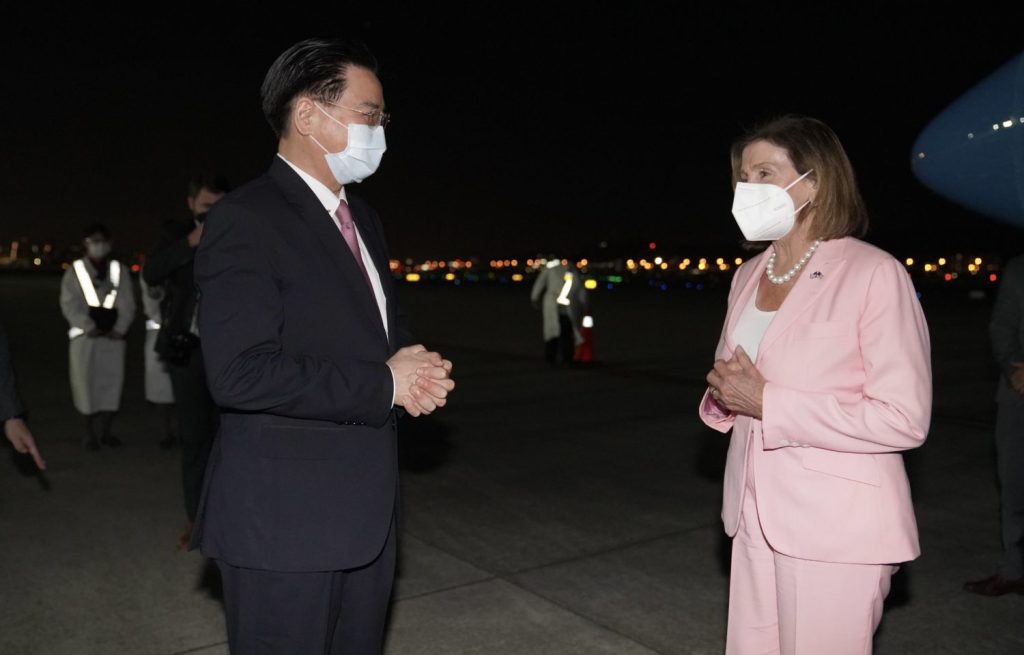
She actually did it: Despite all the warnings and crisis scenarios, Nancy Pelosi flew to Taiwan on Tuesday – with the whole world watching. Hundreds of thousands across the globe, and at times as many as 30 million people in China, followed on online flight trackers how the US Air Force Boeing with Pelosi on board departed from Kuala Lumpur and landed in Taiwan late in the evening, local time. The tracking app Flight Radar even temporarily collapsed under the huge traffic.
Almost at the exact moment the plane had set down, the Chinese reaction arrived. The People’s Liberation Army dispatched SU-35 fighter jets along the median line between Taiwan and Mainland China. It was one of the reactions that experts had anticipated. Chinese state television aired only a short report about the jet deployment. After the threatening gestures of the past few days (China.Table reported), this seemed downright reserved. As recently as Tuesday afternoon, Foreign Ministry spokeswoman Hua Chunying had warned of “strong countermeasures”.
Even before Pelosi’s arrival, two naval maneuvers had been launched and were continuing on Tuesday evening – albeit far away from Taiwan in the Bohai Sea and in the South China Sea. The presidential office of Tsai Ing-wen also reported that hackers had temporarily shut down the president’s website due to an onslaught of requests.
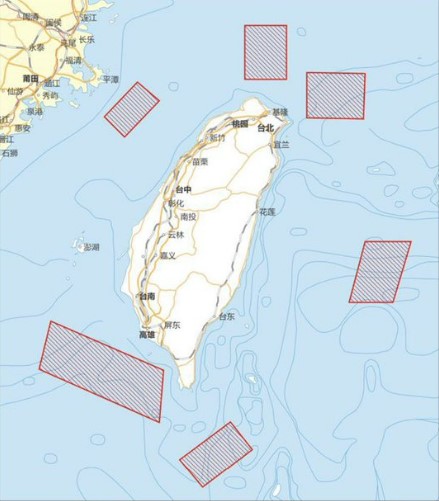
However, news agencies and other state media announced further naval maneuvers in response: “The People’s Liberation Army will conduct important military exercises and training activities including live-fire drills in six regions surrounding the Taiwan island from Thursday to Sunday.” The exclusion zones on the map bear an almost alarming resemblance to the way Russian units encircled Ukraine and conducted “maneuvers” prior to the invasion – the psychological effect has certainly been factored in. What is important to note, however, is that by the time the maneuvers begin around Taiwan, Pelosi will already have left.
The reactions so far, from Chinese fighter jets stalking the median line to the announcement of drills, have been far from the worst-case scenario. China did not interfere with Pelosi’s approach, nor did PLA jets fly over Taiwan proper. The big bang never came.
And then Pelosi stepped out of the plane in the dark, dressed in a pink suit and face mask, escorted by a small delegation. She also stopped for first photos. And perhaps she saw the welcome message on Taiwan’s tallest building, the Taipei 101 skyscraper, on her way to the hotel: “Long live the friendship between the USA and Taiwan,” as well as the words “Thank you” and “Speaker Pelosi” in English.
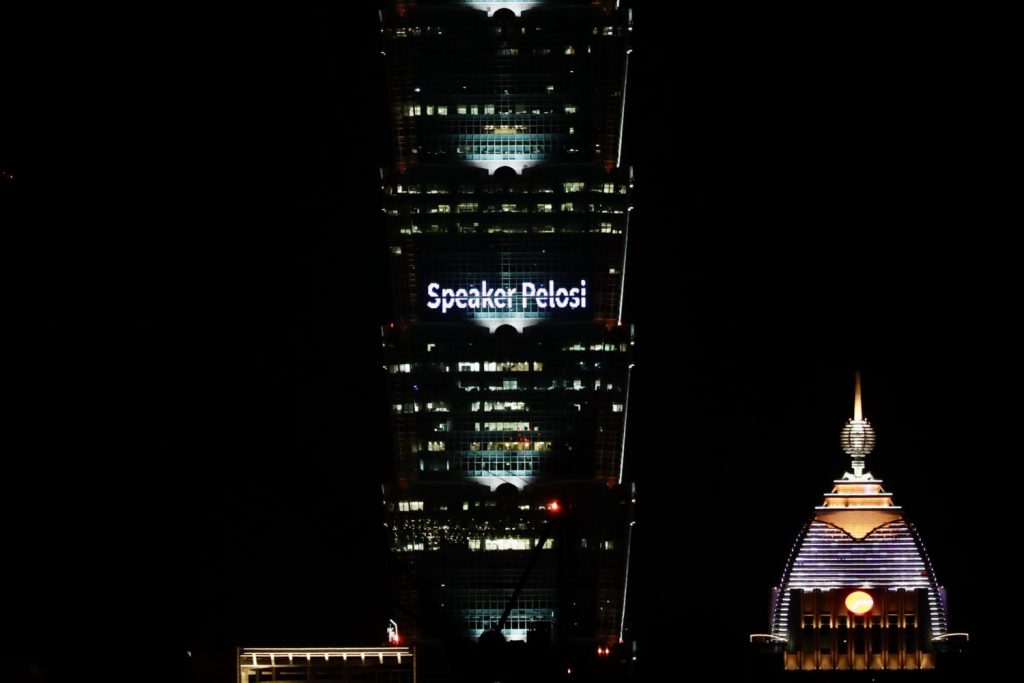
Only minutes later, Pelosi’s first tweet followed, “Our delegation’s visit to Taiwan honors America’s unwavering commitment to supporting Taiwan’s vibrant Democracy.” The talks with the Taiwanese government “reaffirm our support for our partner & promote our shared interests, including advancing a free & open Indo-Pacific region.”
Parallel to the landing, the US newspaper Washington Post published a guest article by Pelosi in which she explains her reasons. She places her visit in a continuum of US policy in support of a “democratic Taiwan”. “It fostered a deep friendship rooted in shared interests and values: self-determination and self-government, democracy and freedom, human dignity and human rights.” Her visit would not represent a break with the existing lines, but would be their logical continuation.
China picked up the exact opposite interpretation: Pelosi’s visit was a “dangerous act of playing with fire” and violated the “one-China principle,” the official Xinhua news agency wrote in a commentary that went online on state media sites at the moment of the landing. The Taiwan Affairs Office also expressed sharp criticism. Pelosi was sending a fatal signal to the forces of Taiwan’s independence that could only lead to disaster. The tone in Beijing points to deeper and lasting damage to the US-China relationship. Beijing does not forget.
Even if Pelosi has won on the surface: She has not yet scored a 1:0 for the US. Pelosi’s visit, which is also quite controversial in Washington, has damaged relations between the two superpowers. Only time will tell to what extent. Pelosi’s arrival in Taiwan now opens an “era of high-intensity competition between China and US over Taiwan Strait,” wrote Hu Xijin, the ever-tweeting former editor-in-chief of the propaganda paper Global Times, who is known to be a hothead, and who earlier even suggested that the speaker’s plane might be shot down. “Taiwan is close to Chinese mainland and Beijing has sufficient cards at hand. We will play them one by one confidently,” Hu wrote. One by one, at least that doesn’t sound like an invasion or full-blown assault on US aircraft carriers in the region.
Fittingly, China unsurprisingly received renewed support from Russia on Tuesday. “Everything about this tour and the possible visit to Taiwan is purely provocative,” Kremlin spokesman Dmitry Peskov told reporters – at a time when it was still unclear whether Pelosi would actually fly to Taipei.
On Monday, Foreign Minister Sergey Lavrov already demonstratively backed the country’s “one China” policy. Both called Taiwan part of China and labeled the US a provocateur. It is a closing of ranks, but it remains unclear how poisoned it is. Is Russia trying to lure China into even more unequivocal support for Moscow for the Ukraine war? Beijing has always neatly separated the Ukraine and Taiwan conflicts: Ukraine is a sovereign country; Taiwan is part of China.
Meanwhile, new German Ambassador Patricia Flor tweeted of “open discussions” with Vice Minister Deng Li after her first visit to the Foreign Ministry on this day of all days – and reiterated Foreign Minister Annalena Baerbock’s words on the Taiwan conflict at the United Nations earlier this week: “The threat of military force is unacceptable under any circumstances.”
The answer followed quickly. Chen Weihua, EU bureau chief of the state-run newspaper China Daily, fired back: “Under any circumstances? If Taiwan moves towards independence, that will trigger a war. Just thought you understand China more than your ignorant Foreign Minister.” This remark by a media representative in government service may be a sign of a new tone, even harsher than already familiar words by “wolf warriors” around foreign office spokesman Zhao Lijian.
The fact is that Europe will not be immune to the tensions, either – because Europeans have also begun to show increasing solidarity with Taiwan. Just recently, Nicola Beer, Vice President of the EU Parliament, visited Taiwan. Members from the British parliament are apparently also planning a visit. According to a report in The Guardian newspaper on Monday, the parliament’s Foreign Affairs Committee is planning to visit the island republic in November or December, citing unnamed sources. No comments were initially available from the Committee or Taiwanese representatives, according to Reuters. But Pelosi also made no mention before her arrival in Taipei.
It should be noted that it is members of parliament, not government officials nor high-ranking members of the government, who are visiting Taiwan – the West seems to be unanimous on that. On Monday, US Secretary of State Antony Blinken stressed that Congress would independently decide on such matters.
Jake Sullivan, National Security Advisor, reminded that Pelosi was not the only Speaker of the House to have been to Taiwan. Twenty-five years ago, then-Speaker Newt Gingrich visited Taipei. “Members of Congress travel there all the time, including several who have already traveled there this year,” Sullivan said on Tuesday. “So for China to try to turn what is in the historical norm into a crisis or to try to use it as a pretext for aggressive action around Taiwan, that’s on them and they would be the ones who’d be escalating.” According to Sullivan, the United States has no interest in escalation.
When Newt Gingrich traveled to Taiwan in 1997, Beijing’s reaction, albeit angry, remained within familiar limits. But that would no longer count today, China’s UN ambassador stressed at a press conference on Monday: “An early mistake does not make the following mistake legitimate.” Gingrich headed for both Taiwan and China, while Pelosi now avoids the People’s Republic.
But China not only responded with military force; it also reached into its toolbox for coercive economic measures. It was revealed on Tuesday that customs stopped shipments from more than 100 Taiwanese food exporters on Monday. The affected goods included seafood, tea, cookies, baked goods, bread and honey, Bloomberg and the South China Morning Post each reported, citing Chinese customs authorities.
According to reports in the Taipei-based newspaper Apple Daily, the Chinese side cited outdated information on import documents as the reason. In the dispute with Lithuania over the establishment of a Taiwan office in Vilnius, China’s customs have also repeatedly stopped goods from the EU country since 2021 over flimsy reasons, including beef, dairy products and alcohol.
Such a policy of economic pressure against Taiwan is nothing new. For some time, Beijing has blocked the import of certain fruits, such as pineapples. These are largely grown in southern Taiwan, where support for President Tsai Ing-wen is particularly strong. Tsai and her Democratic Progressive Party are regarded in Beijing as supporters of independence.
Pelosi’s detour to Taiwan certainly underlined the US commitment to protect Taiwan. “America’s solidarity with the 23 million people of Taiwan is more important today than ever, as the world faces a choice between autocracy and democracy,” Pelosi’s office announced after her arrival. Hopefully, her trip will be of actual benefit to the people of Taiwan. It could very well be that she has made the situation more complicated for the foreseeable future.
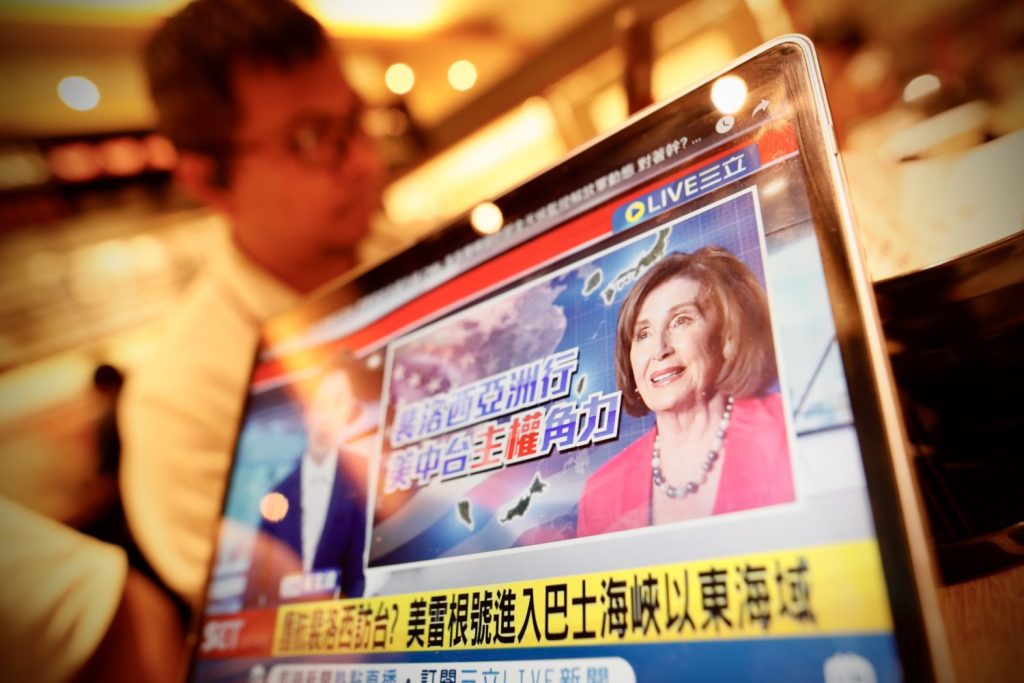
Taiwan’s military had been on high alert for days. The Ministry of Defense stressed as late as Tuesday morning that it was ready to deploy its armed forces should China decide to launch a military intervention after Pelosi’s arrival. With an explosive mix of patriotism and sensationalism, hundreds of thousands of Chinese Internet users watched as the US politician landed In China, hundreds of thousands of Internet users followed the U.S. politician’s landing approach with an explosive mix of patriotism and sensationalism – while high-ranking Chinese state officials posted videos on Twitter to prove the power of the People’s Liberation Army to the West once more. Other videos showed armored divisions rolling into Xiamen, on the Chinese side of the Taiwan Strait.
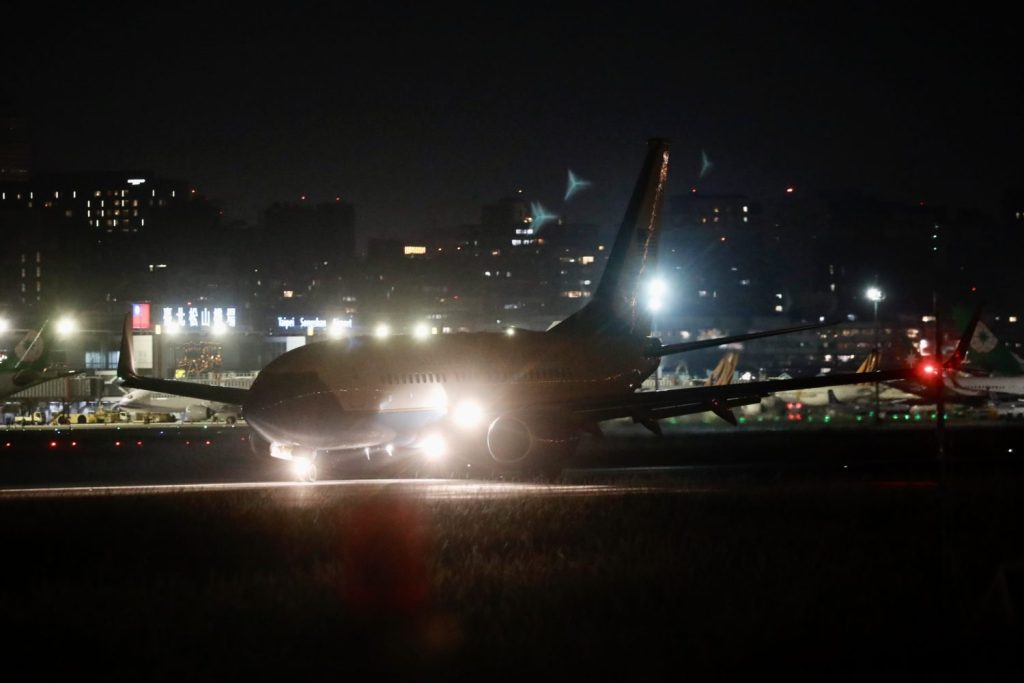
The people of Taiwan, the supposed flashpoint, on the other hand, appeared rather calm after Pelosi landed, as they had been throughout the entire Pelosi saga. “To be honest, I didn’t pay any attention to the whole thing and only found out about her visit yesterday,” says 40-year-old film producer Lin Yu-ting, for example.
Lin is old enough to remember the previous “Taiwan Strait Crisis” of 1996. At that time, China staged a series of missile tests in protest against the first direct democratic presidential election in Taiwan and the policies of incumbent Lee Teng-hui, who was accused of abandoning the One China policy. This is another reason why Lin is not afraid of escalation now. “After all, China has been ranting for decades. Sometimes they rant louder and sometimes they rant quieter, that’s all it is.”
Yu Cheng-wei, 29, also does not see the US politician’s visit as a watershed moment on the Taiwan issue. “Personally, I welcome Pelosi’s Taiwan trip,” says the young man, who is currently preparing for a civil service career. “In other countries, it is also quite normal for political leaders to visit. In Taiwan’s case, it should be no different.”
Yu considers it highly unlikely that an open military conflict with China will now erupt. “That would be a direct conflict with the United States. China is not yet militarily capable of that.” With the upcoming 20th CCP Congress, this would also not be particularly beneficial for Chinese domestic politics. Nevertheless, caution is still called for, Yu says: “From Taiwan’s point of view, we can’t afford to be the first to open fire.”
The people of Taiwan are well aware of the risk of an invasion. At the same time, however, they have long since grown accustomed to the threats from Beijing. “Fear is useless. What happens, happens,” says Hsu En-en. The 29-year-old lives in Kaohsiung, a port city right at the South China Sea, where she records podcasts about movies and literature. But the announcement of maneuvers for this week, in which China’s military virtually wants to encircle Taiwan, could actually be yet another level of escalation.
“I do have some basic awareness of the danger of military conflict,” Hsu says. She said she has already stockpiled supplies because of the Ukraine war and frequent natural disasters in Taiwan. “The danger is definitely from China. Even in advance, they repeatedly threatened us. That’s the reason why this visit suddenly seems so dangerous.” Despite everything, she will not allow herself to be driven crazy. “We’ll just go on living our lives, eating ramen and drinking bubble tea.”
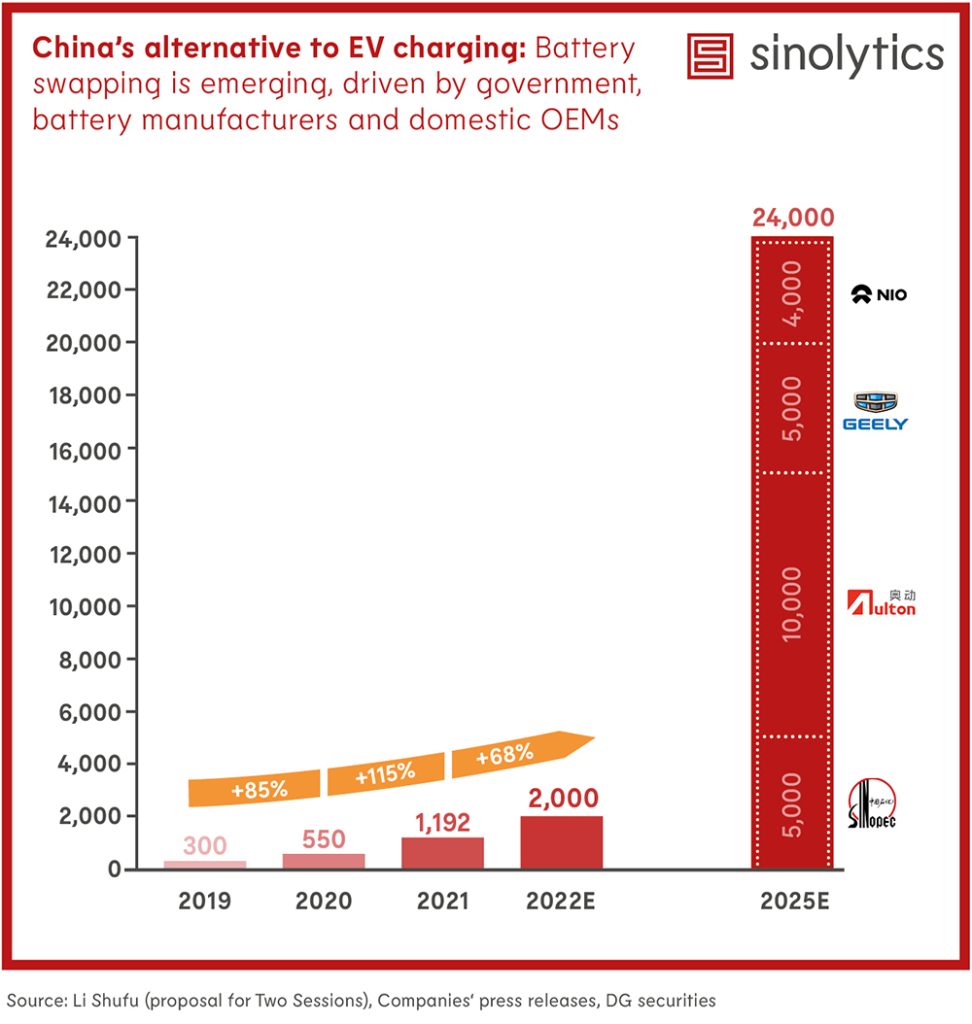
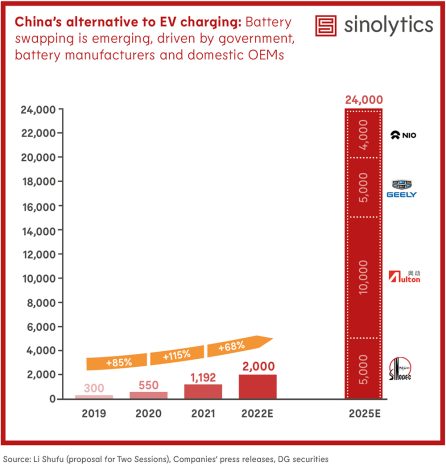
Sinolytics is a European research-based consultancy entirely focused on China. It advises European companies on their strategic orientation and concrete business activities in the People’s Republic.
China has apparently expanded its nuclear testing facilities in the autonomous region of Xinjiang. This is indicated by satellite images published earlier this week by the Japanese newspaper Nikkei Asia and evaluated in cooperation with nuclear experts.
According to the report, extensive covers have been erected on a mountainside at China’s Lop Nur nuclear weapons test site in southeastern Xinjiang. Boulders piled up nearby are said to indicate a new, sixth tunnel where underground nuclear tests “could resume at any time,” an expert from All-Source Analysis, a private US geospatial data company, told Nikkei.
Increased construction work has been observed in the area for two years now. Recent activities include power transmission cables and a facility that could be used to store explosives. An official Chinese procurement website also posted a tender in April for “10 radiation alarms” and “12 protective suits,” the newspaper said.
The fifth and so far last underground nuclear test was carried out in Lop Nur in 1996. At the time, China declared that it would stop its nuclear tests as a result of the Nuclear Test Ban Treaty. According to a report published in June by the Stockholm-based peace research institute Sipri, Russia and the United States possess the world’s largest arsenal, with 5,977 and 5,428 nuclear warheads, respectively. China follows in third place with 350 nuclear warheads. According to Sipiri, however, the People’s Republic is currently in the process of considerably expanding its nuclear arsenal. Satellite images indicate the construction of more than 300 new missile silos. fpe
As expected, the State Council has postponed the end of subsidies for the purchase of cars with eco-friendly engines. The subsidies were originally supposed to expire at the end of 2022. Now they will continue to apply for the time being, according to reports from the state broadcaster CCTV on Friday. The news portal Caixin first reported on the extension.
One of the reasons for the extension of subsidies is the weak economy. China originally intended to allow market-based prices for EVs in the future. Instead, manufacturers were forced via regulations to accelerate the transition to electromobility. However, after the Covid lockdowns, Premier Li Keqiang wants to use several means to stimulate consumption. fin
China aims to peak carbon emissions in the industrial sector between 2026 and 2029. This was revealed in a newly published plan by the Ministry of Industry and Environment and central planning authorities, wrote China expert Lauri Myllyvirta of the Centre for Research on Energy and Clean Air on Twitter on Tuesday. However, the plan does not include concrete and measurable targets. The new plans, however, fall short of earlier drafts, which, for example, had set the emissions peak for the steel and concrete sectors as early as 2025. At least the new document confirms that there will be specific plans for peaks in the four major energy-intensive sectors of steel, construction materials, chemicals and non-ferrous metals: “These could still set firmer targets.”
China’s emissions – including industrial emissions – have been declining for about a year due to a combination of an economic slowdown, financial woes and a growth of renewables, according to Myllyvirta. In the full calendar year of 2021, they were still up about four percent, according to the statistics bureau (China.Table reported). China’s 30/60 climate targets call for a general emissions peak by 2030 and carbon neutrality by 2060.
But Beijing wants energy-intensive sectors in particular to lead the way. “Heavy industries benefit from electrification, which shifts some of their emissions to the power sector,” Myllyvirta writes. “Therefore, they have to be able to peak early.” This is particularly true if renewables continue to rapidly increase their share of the power supply.
The expert assumes that the concrete sector has already passed its emissions peak and that steel is also already recording declining values by 2030, partly due to the greater use of scrap metal. Therefore, he believes that real reductions may be achieved faster than the modest plans envisage. ck
The EV manufacturer NIO plans to open its first EU plant in September. This was reported by the financial magazine Caixin, citing a company source. The plant in the city of Pest in Hungary will be 10,000 square meters in size and is expected to produce charging stations and battery swap stations for European customers, Caixin stated. NIO reportedly will also offer after-sales services at the site.
Entering the European market has great significance for NIO. NIO is already active in Norway, which is considered the gateway to Europe with its NEV-friendly policies for several Chinese EV companies. The company has set up a charging station and battery swap station in Norway and sold 750 cars so far, Caixin writes, citing industry data. NIO also plans to sell its cars in countries including France, Germany and the Netherlands. ck

The widely acclaimed globalization of the post-Cold War era is now running in reverse. A protracted slowdown in global trade has been reinforced by persistent pandemic-related supply-chain disruptions, ongoing pressures of the US-China trade war, and efforts to align cross-border economic ties with geostrategic alliances (“friend-shoring“). These developments tighten the noose on China, arguably the country that has been the greatest beneficiary of modern globalization.
Of the many metrics of globalization, including financial, information, and labor flows, the cross-border exchange of goods and services is most closely tied to economic growth. Largely for that reason, the slowdown in global trade, which commenced in the aftermath of the 2008-09 global financial crisis and intensified in the COVID-19 era, points to a sea change in globalization. While global exports went from 19 percent of world GDP in 1990 to a peak of 31 percent in 2008, in the thirteen years that followed (2009-21), global exports have averaged just 28.7 percent of world GDP. Had world exports expanded on a 6.4 percent trajectory – halfway between the blistering 9.4 percent pace of 1990-2008 and the subdued post-2008 rate of 3.3 percent – the export share of global GDP would have soared to 46 percent by 2021, far above the actual share of 29 percent.
China’s gains from the globalization of trade have been extraordinary. In the decade prior to China’s 2001 accession to the World Trade Organization, Chinese exports averaged just 2 percent of total world exports. By 2008, that share had risen nearly fourfold, to 7.5 percent. China had timed its WTO membership bid perfectly, just when the global trade cycle was on a major upswing. While the financial crisis took a brief toll on Chinese export momentum, the interruption was short-lived. By 2021, Chinese exports had surged to 12.7 percent of world exports, well above the pre-2008 peak.
China is unlikely to maintain this performance. Overall growth of global trade is slowing, and China’s slice of the trade pie is under mounting pressure.
The ongoing trade war with the United States is especially problematic. During the first phase of China’s export-led growth surge in the aftermath of WTO accession, the US was consistently China’s largest source of external demand. Largely due to former US President Donald Trump’s tariffs, that is no longer the case. By 2020, US imports of Chinese goods and services had fallen 19 percent below the peak levels of 2018. Despite rebounding sharply on the heels of the US economy’s post-pandemic snapback, in 2021, US imports from China remained 5 percent below the 2018 peak. Partial tariff rollbacks for selected consumer products, which President Joe Biden’s administration is apparently considering as an anti-inflation gambit, are unlikely to jump-start bilateral trade.
At the same time, enduring pandemic-related supply-chain disruptions are likely to take a sharp toll on China and the rest of the world. Over the six months ending in April, a “global supply chain pressures index” constructed by researchers at the Federal Reserve Bank of New York averaged 3.6, well above the 2.3 reading in the first 21 months following the February 2020 onset of pandemic-related lockdowns, and sharply higher than the “zero” reading associated with the absence of supply-chain disruptions.
This is a big deal for a world connected by supply chains. Global value chains accounted for more than 70 percent of the cumulative growth in overall global trade from 1993 to 2013, and China has enjoyed an outsize share of this GVC-enabled expansion. As supply-chain disruptions persist, exacerbated by China’s zero-COVID policies, pressures on Chinese and global economic activity are likely to remain intense.
Mounting geostrategic tensions are the wild card in deglobalization, especially their implications for China. “Friend-shoring” in effect turns Ricardo’s efficiency calculus of cross-border trade into an assessment of the security benefits that come from strategic alliances with like-minded countries. China’s new unlimited partnership with Russia looms especially relevant in this regard. With China edging closer to crossing the line by providing support to Russian military efforts in Ukraine, the US has recently moved to impose sanctions on five more Chinese companies through its so-called Entity List.
Moreover, Chinese purchases of Russian energy products provide a major source of support to the Russian economy, thereby countering the impact of unprecedented Western sanctions. That raises the risk of China being judged guilty by association. Meanwhile, signs of financial deglobalization are also evident, with China steadily reducing its holdings of US treasuries to levels not seen since 2010 – hardly a comforting development for a saving-short, deficit-prone US economy.
The US is hardly an innocent bystander in this outbreak of geostrategic tensions. On-again, off-again rumors of an upcoming trip to Taiwan by House Speaker Nancy Pelosi clearly flirt with China’s tripwires regarding what it has defined as one of its core interests. The same can be said of bipartisan support for anti-China legislation slowly making its way through the US Congress.
Just as Russian President Vladimir Putin has attempted to justify his unconscionable aggression in Ukraine as a defense against NATO enlargement, China’s longstanding fears of American containment play to similar anxieties within Chinese leadership circles. Henry Kissinger, the architect of the modern-day US-China policy, recently warned of America’s penchant for “endless confrontation” with China and appealed for “Nixonian flexibility” to resolve an increasingly dangerous conflict. But, as I argue in my upcoming book, Accidental Conflict, it will take far more than that to bring Sino-American conflict escalation to an end.
Globalization was always a catchy term in search of a theory. Yes, trade was the glue that fostered integration of the world economy. But it was hardly the rising tide that lifted all boats. With the world beset by climate change, pandemics, and a shocking new war in Europe – to say nothing of mounting inequality and related social and political tensions – the defense of globalization is in tatters. And China may well have the most to lose.
Stephen S. Roach, a faculty member at Yale University and former chairman of Morgan Stanley Asia, is the author of Unbalanced: The Codependency of America and China (Yale University Press, 2014) and the forthcoming Accidental Conflict: America, China, and the Clash of False Narratives (Yale University Press, November 2022).
Copyright: Project Syndicate, 2022.
www.project-syndicate.org
Guoying Zhu took over the position of Key Account Manager China at mediCAD last month. The German company develops process optimization software for orthopedic surgery. Previously, Zhu was responsible for Sales & Business Development China/Asean for the Bavarian software developer for one and a half years.
Honggang Du has been Team Leader of Online Business at Jungheinrich China in Shanghai since July. The Berlin-trained manager has been working in the metropolis for four years for the Chinese branch of the Hamburg-based intralogistics company, which specializes in material handling equipment, warehousing and material flow technology.
Is something changing in your organization? Why not let us know at heads@table.media?
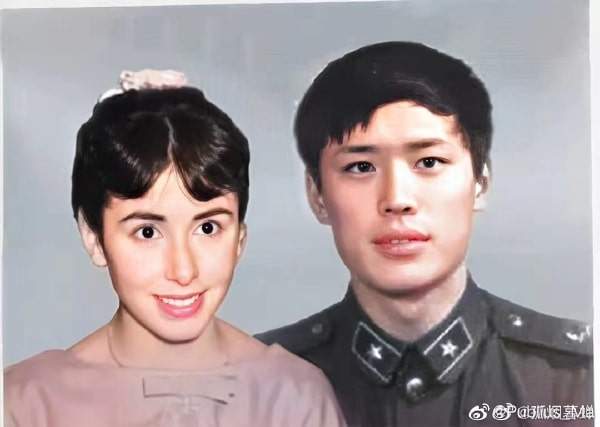
Once upon a time… China’s Internet users reacted creatively to Nancy Pelosi’s Taiwan visit by merging an old yearbook photo of the US politician with a military photo of Hu Xijin, former editor-in-chief of the Global Times. Hu, who commented on Twitter in late July that China had the right to shoot down Pelosi’s plane should it enter Taiwan’s airspace. The fictional wedding picture went viral in several versions – sometimes yellowed and in sepia colors, sometimes dragged through the pastel blur, as known from old Mao Zedong photographs.
The third-highest ranking politician of the USA has landed in Taiwan. As expected, in response to Nancy Pelosi’s arrival, China dispatched its military forces: Aircraft of the Chinese Air Force scratched the center line of the strait between the island and the mainland. In addition, naval exercises with live ammunition will begin on Thursday in the waters around Taiwan. For an assessment of the Chinese response, check our analysis by Christiane Kuehl. Pelosi’s gamble seems to have paid off in the short term because an escalation has failed to materialize. Nonetheless, the United States will have a harder time dealing with China from now on.
China’s overly vocal propagandists now have to row back. But China still holds the stronger cards and will now “play them one by one,” wrote Hu Xijin, the ever vociferous former editor-in-chief of the Global Times, on Twitter. So instead of the “great war in the Taiwan Strait” he announced on Monday, the situation has turned into a card game. (Be sure to check our Dessert section, where Hu Xijin can be seen unusually close with Pelosi).
However, relations between the United States and China will now become even more complicated. Xi Jinping cannot simply overlook the historic visit. Moreover, the risk of a misunderstanding and an unintended escalation have not been averted, especially since both sides are massing warships in the same sea area. Taiwan remains one of the most critical hot spots, alongside the ongoing war in Ukraine, North Korea and Iran.
Pelosi’s visit now strengthens symbolic support for Taiwan, but it comes at a precarious time. The world already looks distraught at one war. And China is at the point where it could push to show its newly regained technological-military strength in action. As commendable as Pelosi’s tenacity is, it has shaken a status quo that secured a delicate peace for decades.
At the same time, however, the reaction on Tuesday evening initially seemed like a game. The moment flight tracking sites signaled Pelosi’s landing, the Chinese and American sides posted their PR pieces online, boldly proclaiming their positions. It was almost reassuring that they used the same phrases as usual.


She actually did it: Despite all the warnings and crisis scenarios, Nancy Pelosi flew to Taiwan on Tuesday – with the whole world watching. Hundreds of thousands across the globe, and at times as many as 30 million people in China, followed on online flight trackers how the US Air Force Boeing with Pelosi on board departed from Kuala Lumpur and landed in Taiwan late in the evening, local time. The tracking app Flight Radar even temporarily collapsed under the huge traffic.
Almost at the exact moment the plane had set down, the Chinese reaction arrived. The People’s Liberation Army dispatched SU-35 fighter jets along the median line between Taiwan and Mainland China. It was one of the reactions that experts had anticipated. Chinese state television aired only a short report about the jet deployment. After the threatening gestures of the past few days (China.Table reported), this seemed downright reserved. As recently as Tuesday afternoon, Foreign Ministry spokeswoman Hua Chunying had warned of “strong countermeasures”.
Even before Pelosi’s arrival, two naval maneuvers had been launched and were continuing on Tuesday evening – albeit far away from Taiwan in the Bohai Sea and in the South China Sea. The presidential office of Tsai Ing-wen also reported that hackers had temporarily shut down the president’s website due to an onslaught of requests.

However, news agencies and other state media announced further naval maneuvers in response: “The People’s Liberation Army will conduct important military exercises and training activities including live-fire drills in six regions surrounding the Taiwan island from Thursday to Sunday.” The exclusion zones on the map bear an almost alarming resemblance to the way Russian units encircled Ukraine and conducted “maneuvers” prior to the invasion – the psychological effect has certainly been factored in. What is important to note, however, is that by the time the maneuvers begin around Taiwan, Pelosi will already have left.
The reactions so far, from Chinese fighter jets stalking the median line to the announcement of drills, have been far from the worst-case scenario. China did not interfere with Pelosi’s approach, nor did PLA jets fly over Taiwan proper. The big bang never came.
And then Pelosi stepped out of the plane in the dark, dressed in a pink suit and face mask, escorted by a small delegation. She also stopped for first photos. And perhaps she saw the welcome message on Taiwan’s tallest building, the Taipei 101 skyscraper, on her way to the hotel: “Long live the friendship between the USA and Taiwan,” as well as the words “Thank you” and “Speaker Pelosi” in English.

Only minutes later, Pelosi’s first tweet followed, “Our delegation’s visit to Taiwan honors America’s unwavering commitment to supporting Taiwan’s vibrant Democracy.” The talks with the Taiwanese government “reaffirm our support for our partner & promote our shared interests, including advancing a free & open Indo-Pacific region.”
Parallel to the landing, the US newspaper Washington Post published a guest article by Pelosi in which she explains her reasons. She places her visit in a continuum of US policy in support of a “democratic Taiwan”. “It fostered a deep friendship rooted in shared interests and values: self-determination and self-government, democracy and freedom, human dignity and human rights.” Her visit would not represent a break with the existing lines, but would be their logical continuation.
China picked up the exact opposite interpretation: Pelosi’s visit was a “dangerous act of playing with fire” and violated the “one-China principle,” the official Xinhua news agency wrote in a commentary that went online on state media sites at the moment of the landing. The Taiwan Affairs Office also expressed sharp criticism. Pelosi was sending a fatal signal to the forces of Taiwan’s independence that could only lead to disaster. The tone in Beijing points to deeper and lasting damage to the US-China relationship. Beijing does not forget.
Even if Pelosi has won on the surface: She has not yet scored a 1:0 for the US. Pelosi’s visit, which is also quite controversial in Washington, has damaged relations between the two superpowers. Only time will tell to what extent. Pelosi’s arrival in Taiwan now opens an “era of high-intensity competition between China and US over Taiwan Strait,” wrote Hu Xijin, the ever-tweeting former editor-in-chief of the propaganda paper Global Times, who is known to be a hothead, and who earlier even suggested that the speaker’s plane might be shot down. “Taiwan is close to Chinese mainland and Beijing has sufficient cards at hand. We will play them one by one confidently,” Hu wrote. One by one, at least that doesn’t sound like an invasion or full-blown assault on US aircraft carriers in the region.
Fittingly, China unsurprisingly received renewed support from Russia on Tuesday. “Everything about this tour and the possible visit to Taiwan is purely provocative,” Kremlin spokesman Dmitry Peskov told reporters – at a time when it was still unclear whether Pelosi would actually fly to Taipei.
On Monday, Foreign Minister Sergey Lavrov already demonstratively backed the country’s “one China” policy. Both called Taiwan part of China and labeled the US a provocateur. It is a closing of ranks, but it remains unclear how poisoned it is. Is Russia trying to lure China into even more unequivocal support for Moscow for the Ukraine war? Beijing has always neatly separated the Ukraine and Taiwan conflicts: Ukraine is a sovereign country; Taiwan is part of China.
Meanwhile, new German Ambassador Patricia Flor tweeted of “open discussions” with Vice Minister Deng Li after her first visit to the Foreign Ministry on this day of all days – and reiterated Foreign Minister Annalena Baerbock’s words on the Taiwan conflict at the United Nations earlier this week: “The threat of military force is unacceptable under any circumstances.”
The answer followed quickly. Chen Weihua, EU bureau chief of the state-run newspaper China Daily, fired back: “Under any circumstances? If Taiwan moves towards independence, that will trigger a war. Just thought you understand China more than your ignorant Foreign Minister.” This remark by a media representative in government service may be a sign of a new tone, even harsher than already familiar words by “wolf warriors” around foreign office spokesman Zhao Lijian.
The fact is that Europe will not be immune to the tensions, either – because Europeans have also begun to show increasing solidarity with Taiwan. Just recently, Nicola Beer, Vice President of the EU Parliament, visited Taiwan. Members from the British parliament are apparently also planning a visit. According to a report in The Guardian newspaper on Monday, the parliament’s Foreign Affairs Committee is planning to visit the island republic in November or December, citing unnamed sources. No comments were initially available from the Committee or Taiwanese representatives, according to Reuters. But Pelosi also made no mention before her arrival in Taipei.
It should be noted that it is members of parliament, not government officials nor high-ranking members of the government, who are visiting Taiwan – the West seems to be unanimous on that. On Monday, US Secretary of State Antony Blinken stressed that Congress would independently decide on such matters.
Jake Sullivan, National Security Advisor, reminded that Pelosi was not the only Speaker of the House to have been to Taiwan. Twenty-five years ago, then-Speaker Newt Gingrich visited Taipei. “Members of Congress travel there all the time, including several who have already traveled there this year,” Sullivan said on Tuesday. “So for China to try to turn what is in the historical norm into a crisis or to try to use it as a pretext for aggressive action around Taiwan, that’s on them and they would be the ones who’d be escalating.” According to Sullivan, the United States has no interest in escalation.
When Newt Gingrich traveled to Taiwan in 1997, Beijing’s reaction, albeit angry, remained within familiar limits. But that would no longer count today, China’s UN ambassador stressed at a press conference on Monday: “An early mistake does not make the following mistake legitimate.” Gingrich headed for both Taiwan and China, while Pelosi now avoids the People’s Republic.
But China not only responded with military force; it also reached into its toolbox for coercive economic measures. It was revealed on Tuesday that customs stopped shipments from more than 100 Taiwanese food exporters on Monday. The affected goods included seafood, tea, cookies, baked goods, bread and honey, Bloomberg and the South China Morning Post each reported, citing Chinese customs authorities.
According to reports in the Taipei-based newspaper Apple Daily, the Chinese side cited outdated information on import documents as the reason. In the dispute with Lithuania over the establishment of a Taiwan office in Vilnius, China’s customs have also repeatedly stopped goods from the EU country since 2021 over flimsy reasons, including beef, dairy products and alcohol.
Such a policy of economic pressure against Taiwan is nothing new. For some time, Beijing has blocked the import of certain fruits, such as pineapples. These are largely grown in southern Taiwan, where support for President Tsai Ing-wen is particularly strong. Tsai and her Democratic Progressive Party are regarded in Beijing as supporters of independence.
Pelosi’s detour to Taiwan certainly underlined the US commitment to protect Taiwan. “America’s solidarity with the 23 million people of Taiwan is more important today than ever, as the world faces a choice between autocracy and democracy,” Pelosi’s office announced after her arrival. Hopefully, her trip will be of actual benefit to the people of Taiwan. It could very well be that she has made the situation more complicated for the foreseeable future.

Taiwan’s military had been on high alert for days. The Ministry of Defense stressed as late as Tuesday morning that it was ready to deploy its armed forces should China decide to launch a military intervention after Pelosi’s arrival. With an explosive mix of patriotism and sensationalism, hundreds of thousands of Chinese Internet users watched as the US politician landed In China, hundreds of thousands of Internet users followed the U.S. politician’s landing approach with an explosive mix of patriotism and sensationalism – while high-ranking Chinese state officials posted videos on Twitter to prove the power of the People’s Liberation Army to the West once more. Other videos showed armored divisions rolling into Xiamen, on the Chinese side of the Taiwan Strait.

The people of Taiwan, the supposed flashpoint, on the other hand, appeared rather calm after Pelosi landed, as they had been throughout the entire Pelosi saga. “To be honest, I didn’t pay any attention to the whole thing and only found out about her visit yesterday,” says 40-year-old film producer Lin Yu-ting, for example.
Lin is old enough to remember the previous “Taiwan Strait Crisis” of 1996. At that time, China staged a series of missile tests in protest against the first direct democratic presidential election in Taiwan and the policies of incumbent Lee Teng-hui, who was accused of abandoning the One China policy. This is another reason why Lin is not afraid of escalation now. “After all, China has been ranting for decades. Sometimes they rant louder and sometimes they rant quieter, that’s all it is.”
Yu Cheng-wei, 29, also does not see the US politician’s visit as a watershed moment on the Taiwan issue. “Personally, I welcome Pelosi’s Taiwan trip,” says the young man, who is currently preparing for a civil service career. “In other countries, it is also quite normal for political leaders to visit. In Taiwan’s case, it should be no different.”
Yu considers it highly unlikely that an open military conflict with China will now erupt. “That would be a direct conflict with the United States. China is not yet militarily capable of that.” With the upcoming 20th CCP Congress, this would also not be particularly beneficial for Chinese domestic politics. Nevertheless, caution is still called for, Yu says: “From Taiwan’s point of view, we can’t afford to be the first to open fire.”
The people of Taiwan are well aware of the risk of an invasion. At the same time, however, they have long since grown accustomed to the threats from Beijing. “Fear is useless. What happens, happens,” says Hsu En-en. The 29-year-old lives in Kaohsiung, a port city right at the South China Sea, where she records podcasts about movies and literature. But the announcement of maneuvers for this week, in which China’s military virtually wants to encircle Taiwan, could actually be yet another level of escalation.
“I do have some basic awareness of the danger of military conflict,” Hsu says. She said she has already stockpiled supplies because of the Ukraine war and frequent natural disasters in Taiwan. “The danger is definitely from China. Even in advance, they repeatedly threatened us. That’s the reason why this visit suddenly seems so dangerous.” Despite everything, she will not allow herself to be driven crazy. “We’ll just go on living our lives, eating ramen and drinking bubble tea.”


Sinolytics is a European research-based consultancy entirely focused on China. It advises European companies on their strategic orientation and concrete business activities in the People’s Republic.
China has apparently expanded its nuclear testing facilities in the autonomous region of Xinjiang. This is indicated by satellite images published earlier this week by the Japanese newspaper Nikkei Asia and evaluated in cooperation with nuclear experts.
According to the report, extensive covers have been erected on a mountainside at China’s Lop Nur nuclear weapons test site in southeastern Xinjiang. Boulders piled up nearby are said to indicate a new, sixth tunnel where underground nuclear tests “could resume at any time,” an expert from All-Source Analysis, a private US geospatial data company, told Nikkei.
Increased construction work has been observed in the area for two years now. Recent activities include power transmission cables and a facility that could be used to store explosives. An official Chinese procurement website also posted a tender in April for “10 radiation alarms” and “12 protective suits,” the newspaper said.
The fifth and so far last underground nuclear test was carried out in Lop Nur in 1996. At the time, China declared that it would stop its nuclear tests as a result of the Nuclear Test Ban Treaty. According to a report published in June by the Stockholm-based peace research institute Sipri, Russia and the United States possess the world’s largest arsenal, with 5,977 and 5,428 nuclear warheads, respectively. China follows in third place with 350 nuclear warheads. According to Sipiri, however, the People’s Republic is currently in the process of considerably expanding its nuclear arsenal. Satellite images indicate the construction of more than 300 new missile silos. fpe
As expected, the State Council has postponed the end of subsidies for the purchase of cars with eco-friendly engines. The subsidies were originally supposed to expire at the end of 2022. Now they will continue to apply for the time being, according to reports from the state broadcaster CCTV on Friday. The news portal Caixin first reported on the extension.
One of the reasons for the extension of subsidies is the weak economy. China originally intended to allow market-based prices for EVs in the future. Instead, manufacturers were forced via regulations to accelerate the transition to electromobility. However, after the Covid lockdowns, Premier Li Keqiang wants to use several means to stimulate consumption. fin
China aims to peak carbon emissions in the industrial sector between 2026 and 2029. This was revealed in a newly published plan by the Ministry of Industry and Environment and central planning authorities, wrote China expert Lauri Myllyvirta of the Centre for Research on Energy and Clean Air on Twitter on Tuesday. However, the plan does not include concrete and measurable targets. The new plans, however, fall short of earlier drafts, which, for example, had set the emissions peak for the steel and concrete sectors as early as 2025. At least the new document confirms that there will be specific plans for peaks in the four major energy-intensive sectors of steel, construction materials, chemicals and non-ferrous metals: “These could still set firmer targets.”
China’s emissions – including industrial emissions – have been declining for about a year due to a combination of an economic slowdown, financial woes and a growth of renewables, according to Myllyvirta. In the full calendar year of 2021, they were still up about four percent, according to the statistics bureau (China.Table reported). China’s 30/60 climate targets call for a general emissions peak by 2030 and carbon neutrality by 2060.
But Beijing wants energy-intensive sectors in particular to lead the way. “Heavy industries benefit from electrification, which shifts some of their emissions to the power sector,” Myllyvirta writes. “Therefore, they have to be able to peak early.” This is particularly true if renewables continue to rapidly increase their share of the power supply.
The expert assumes that the concrete sector has already passed its emissions peak and that steel is also already recording declining values by 2030, partly due to the greater use of scrap metal. Therefore, he believes that real reductions may be achieved faster than the modest plans envisage. ck
The EV manufacturer NIO plans to open its first EU plant in September. This was reported by the financial magazine Caixin, citing a company source. The plant in the city of Pest in Hungary will be 10,000 square meters in size and is expected to produce charging stations and battery swap stations for European customers, Caixin stated. NIO reportedly will also offer after-sales services at the site.
Entering the European market has great significance for NIO. NIO is already active in Norway, which is considered the gateway to Europe with its NEV-friendly policies for several Chinese EV companies. The company has set up a charging station and battery swap station in Norway and sold 750 cars so far, Caixin writes, citing industry data. NIO also plans to sell its cars in countries including France, Germany and the Netherlands. ck

The widely acclaimed globalization of the post-Cold War era is now running in reverse. A protracted slowdown in global trade has been reinforced by persistent pandemic-related supply-chain disruptions, ongoing pressures of the US-China trade war, and efforts to align cross-border economic ties with geostrategic alliances (“friend-shoring“). These developments tighten the noose on China, arguably the country that has been the greatest beneficiary of modern globalization.
Of the many metrics of globalization, including financial, information, and labor flows, the cross-border exchange of goods and services is most closely tied to economic growth. Largely for that reason, the slowdown in global trade, which commenced in the aftermath of the 2008-09 global financial crisis and intensified in the COVID-19 era, points to a sea change in globalization. While global exports went from 19 percent of world GDP in 1990 to a peak of 31 percent in 2008, in the thirteen years that followed (2009-21), global exports have averaged just 28.7 percent of world GDP. Had world exports expanded on a 6.4 percent trajectory – halfway between the blistering 9.4 percent pace of 1990-2008 and the subdued post-2008 rate of 3.3 percent – the export share of global GDP would have soared to 46 percent by 2021, far above the actual share of 29 percent.
China’s gains from the globalization of trade have been extraordinary. In the decade prior to China’s 2001 accession to the World Trade Organization, Chinese exports averaged just 2 percent of total world exports. By 2008, that share had risen nearly fourfold, to 7.5 percent. China had timed its WTO membership bid perfectly, just when the global trade cycle was on a major upswing. While the financial crisis took a brief toll on Chinese export momentum, the interruption was short-lived. By 2021, Chinese exports had surged to 12.7 percent of world exports, well above the pre-2008 peak.
China is unlikely to maintain this performance. Overall growth of global trade is slowing, and China’s slice of the trade pie is under mounting pressure.
The ongoing trade war with the United States is especially problematic. During the first phase of China’s export-led growth surge in the aftermath of WTO accession, the US was consistently China’s largest source of external demand. Largely due to former US President Donald Trump’s tariffs, that is no longer the case. By 2020, US imports of Chinese goods and services had fallen 19 percent below the peak levels of 2018. Despite rebounding sharply on the heels of the US economy’s post-pandemic snapback, in 2021, US imports from China remained 5 percent below the 2018 peak. Partial tariff rollbacks for selected consumer products, which President Joe Biden’s administration is apparently considering as an anti-inflation gambit, are unlikely to jump-start bilateral trade.
At the same time, enduring pandemic-related supply-chain disruptions are likely to take a sharp toll on China and the rest of the world. Over the six months ending in April, a “global supply chain pressures index” constructed by researchers at the Federal Reserve Bank of New York averaged 3.6, well above the 2.3 reading in the first 21 months following the February 2020 onset of pandemic-related lockdowns, and sharply higher than the “zero” reading associated with the absence of supply-chain disruptions.
This is a big deal for a world connected by supply chains. Global value chains accounted for more than 70 percent of the cumulative growth in overall global trade from 1993 to 2013, and China has enjoyed an outsize share of this GVC-enabled expansion. As supply-chain disruptions persist, exacerbated by China’s zero-COVID policies, pressures on Chinese and global economic activity are likely to remain intense.
Mounting geostrategic tensions are the wild card in deglobalization, especially their implications for China. “Friend-shoring” in effect turns Ricardo’s efficiency calculus of cross-border trade into an assessment of the security benefits that come from strategic alliances with like-minded countries. China’s new unlimited partnership with Russia looms especially relevant in this regard. With China edging closer to crossing the line by providing support to Russian military efforts in Ukraine, the US has recently moved to impose sanctions on five more Chinese companies through its so-called Entity List.
Moreover, Chinese purchases of Russian energy products provide a major source of support to the Russian economy, thereby countering the impact of unprecedented Western sanctions. That raises the risk of China being judged guilty by association. Meanwhile, signs of financial deglobalization are also evident, with China steadily reducing its holdings of US treasuries to levels not seen since 2010 – hardly a comforting development for a saving-short, deficit-prone US economy.
The US is hardly an innocent bystander in this outbreak of geostrategic tensions. On-again, off-again rumors of an upcoming trip to Taiwan by House Speaker Nancy Pelosi clearly flirt with China’s tripwires regarding what it has defined as one of its core interests. The same can be said of bipartisan support for anti-China legislation slowly making its way through the US Congress.
Just as Russian President Vladimir Putin has attempted to justify his unconscionable aggression in Ukraine as a defense against NATO enlargement, China’s longstanding fears of American containment play to similar anxieties within Chinese leadership circles. Henry Kissinger, the architect of the modern-day US-China policy, recently warned of America’s penchant for “endless confrontation” with China and appealed for “Nixonian flexibility” to resolve an increasingly dangerous conflict. But, as I argue in my upcoming book, Accidental Conflict, it will take far more than that to bring Sino-American conflict escalation to an end.
Globalization was always a catchy term in search of a theory. Yes, trade was the glue that fostered integration of the world economy. But it was hardly the rising tide that lifted all boats. With the world beset by climate change, pandemics, and a shocking new war in Europe – to say nothing of mounting inequality and related social and political tensions – the defense of globalization is in tatters. And China may well have the most to lose.
Stephen S. Roach, a faculty member at Yale University and former chairman of Morgan Stanley Asia, is the author of Unbalanced: The Codependency of America and China (Yale University Press, 2014) and the forthcoming Accidental Conflict: America, China, and the Clash of False Narratives (Yale University Press, November 2022).
Copyright: Project Syndicate, 2022.
www.project-syndicate.org
Guoying Zhu took over the position of Key Account Manager China at mediCAD last month. The German company develops process optimization software for orthopedic surgery. Previously, Zhu was responsible for Sales & Business Development China/Asean for the Bavarian software developer for one and a half years.
Honggang Du has been Team Leader of Online Business at Jungheinrich China in Shanghai since July. The Berlin-trained manager has been working in the metropolis for four years for the Chinese branch of the Hamburg-based intralogistics company, which specializes in material handling equipment, warehousing and material flow technology.
Is something changing in your organization? Why not let us know at heads@table.media?

Once upon a time… China’s Internet users reacted creatively to Nancy Pelosi’s Taiwan visit by merging an old yearbook photo of the US politician with a military photo of Hu Xijin, former editor-in-chief of the Global Times. Hu, who commented on Twitter in late July that China had the right to shoot down Pelosi’s plane should it enter Taiwan’s airspace. The fictional wedding picture went viral in several versions – sometimes yellowed and in sepia colors, sometimes dragged through the pastel blur, as known from old Mao Zedong photographs.
